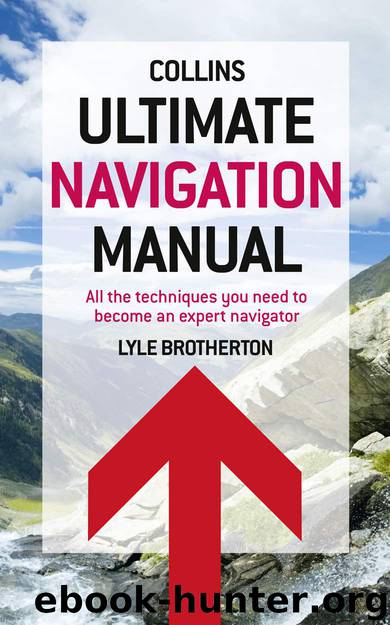Ultimate Navigation Manual by Lyle Brotherton

Author:Lyle Brotherton [Brotherton, Lyle]
Language: eng
Format: epub
Publisher: HarperCollins Publishers
Published: 2011-09-14T22:00:00+00:00
2 Desert trips can often be for extended periods of time and small solar battery-charging units should be used with rechargeable batteries.
3 Handheld satnavs should not be exposed to direct sunlight in extreme temperatures for long periods of time, so the use of an external antenna should be considered.
4 Familiarise yourself with the use of the latitude and longitude coordinate system.
Specialist techniques
Route planning
Locate and mark refuges and water holes on your map and store them as waypoints in your satnav; a longer route that passes near to these can be much safer than the direct route across the middle of the desert. Familiarise yourself with the climatic changes in the region and local land phenomena: for example, some deserts have arroyos, also called a wash, which temporarily fill with water after either heavy rain or seasonally and can be tens of kilometres across. Make sure that you share the route with every member of the expedition, even if using a local guide, as in an accident, you must be able to describe exactly where you are and also how to escape.
Dead reckoning
Probably the single most important technique employed in desert navigation. Draw up a log of each leg length, bearing and time taken.
Transit lines
After taking a bearing on a distant feature, line it up with an intermediate feature both to use as an Attack Point and as a Transit Line to ensure a straight bearing is followed.
Markers
• Use your tracks created in the sand.
Download
This site does not store any files on its server. We only index and link to content provided by other sites. Please contact the content providers to delete copyright contents if any and email us, we'll remove relevant links or contents immediately.
In a Sunburned Country by Bill Bryson(3021)
Annapurna by Maurice Herzog(2922)
How to Read Nature by Tristan Gooley(2736)
Dangerous Girls by Haas Abigail(2542)
The Lost Art of Reading Nature's Signs by Tristan Gooley(2328)
SAS Survival Handbook by John 'Lofty' Wiseman(2309)
In the Woods by Tana French(2075)
Food and Water in an Emergency by Food & Water In An Emergency(2041)
The Stranger in the Woods by Michael Finkel(1995)
Guns, Germs and Steel by Diamond Jared(1940)
Everest the Cruel Way by Joe Tasker(1877)
Backpacker the Complete Guide to Backpacking by Backpacker Magazine(1871)
Sea Survival Handbook by Keith Colwell(1833)
Wild: From Lost to Found on the Pacific Crest Trail by Cheryl Strayed(1812)
Ultimate Navigation Manual by Lyle Brotherton(1812)
Trail Magic by Trevelyan Quest Edwards & Hazel Edwards(1803)
Welcome to the Goddamn Ice Cube by Blair Braverman(1651)
Birds of the Pacific Northwest by Shewey John; Blount Tim;(1645)
Portland: Including the Coast, Mounts Hood and St. Helens, and the Santiam River by Paul Gerald(1619)
